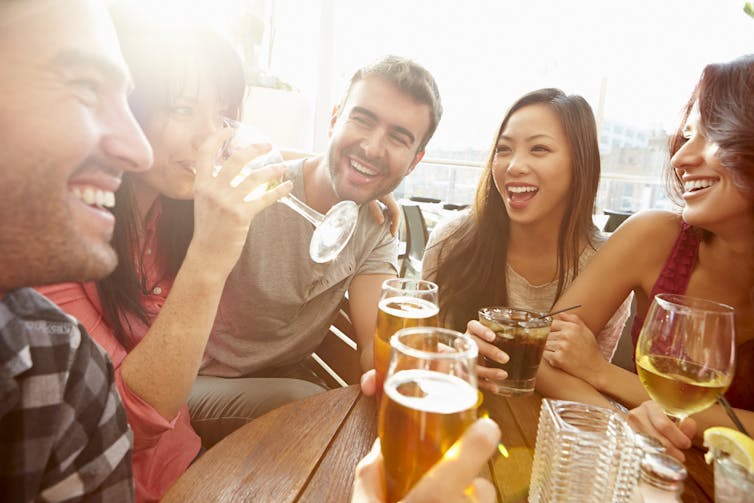How big alcohol is trying to fool us into thinking drinking is safer than it really is
- Written by Peter Miller, Professor of Violence Prevention and Addiction Studies, Deakin University
Over recent weeks, the alcohol industry has been drumming up media discussion around Australia’s new drinking guidelines.
Australia’s guidelines on alcohol consumption are under ongoing review by the National Health and Medical Research Council (NHMRC), with new draft guidelines expected to be released in November.
The alcohol industry has labelled the current guidelines (two standard drinks per day and four in any heavy episode of drinking) as harsh, and voiced concern the guidelines may be tightened further.
Read more: Politicians who become lobbyists can be bad for Australians' health
The global alcohol industry has been increasingly proactive in trying to undermine the ever-improving science on the harms associated with the product they make money from manufacturing, promoting and selling.
This is somewhat unsurprising given the industry would be significantly less profitable if we all drank responsibly.
Drinking guidelines
Panels of scientists develop drinking guidelines around the world by assessing the best and most up-to-date evidence on alcohol and health, and determining consumption levels which might put people at risk.
They then provide the information to health professionals and the public to allow people to make informed decisions about consumption. The guidelines are neither imposed nor legislated.
The current 2009 Australian guidelines recommend healthy adults should drink no more than two standard drinks per day to reduce their lifetime risk of alcohol-related disease or injury. They recommend no more than four standard drinks on one occasion to reduce a person’s risk of injury and death.
So how are the industry players trying to protect our drinking culture from such “harsh” guidelines?
Alcohol Beverages Australia: who they are and what they’re claiming
Alcohol Beverages Australia (ABA) is an industry body for global alcohol producers and retailers, including Asahi Brewers from Japan, Diageo Spirits from the UK, Pernod Ricard from France, Coca-Cola Amatil from the USA, and many others. Bringing together multiple industry groups to lobby government was a key strategy developed by the tobacco industry.
The NHMRC review of Australia’s drinking guidelines was open to public submissions on the health effects of alcohol consumption until January 2017. At this time, the ABA submitted a report claiming drinking alcohol carries health benefits including a reduced risk of heart disease, stroke and diabetes. They requested the review take this into account in drafting any new guidelines.
In their communications with the media this month, the ABA resurfaced their 2017 submission to the process. It seems they have not updated the information to reflect the latest evidence.
Read more: Ten reasons some of us should cut back on alcohol
The most up-to-date evidence has shown previous research was substantially flawed in terms of the relationship between alcohol consumption and heart disease, blood pressure, breast cancer and overall mortality.
We know consuming any type of alcohol increases the risk of developing cancer of the bowel, mouth, pharynx, larynx, oesophagus, liver and breast. The World Health Organisation has classified alcohol as a class 1 carcinogen, along with asbestos and tobacco, for decades.
Any health benefits the ABA demonstrated evidence for is outweighed by the risks.
 The current drinking guidelines in Australia recommend no more than two standard drinks per day for healthy adults.
From shutterstock.com
The current drinking guidelines in Australia recommend no more than two standard drinks per day for healthy adults.
From shutterstock.com
Alongside claiming the benefits of drinking alcohol need to be considered, to make their case, the ABA have compared drinking guidelines across different countries. In doing so, they are seeking to highlight Australia’s guidelines are ‘stricter’ than those of most other countries.
In making sense of these figures, the difference in drink driving levels is worth considering. It takes the average male four standard drinks to reach 0.05 in two hours and around seven standard drinks to reach 0.08. This is a big difference for most of us.
Those countries with 0.08mg of alcohol per L of blood as the legal limit are willing to accept more than triple the risk of having a car accident than Australia’s 0.05.
We need to ask whether these are countries whose health and safety models we want to follow.
Read more: Health check: is moderate drinking good for me?
This is not a new problem
The industry is using language like “harsh” and “strict” to ferment public opposition to any tightened guidelines.
This spin strategy is predictable. The alcohol industry has been fighting for many decades to preserve profits over public safety, disregarding consumers’ rights to know the contents of their products, and the harms associated.
They fought against the 0.05 drink driving limit in the 1950s, and have successfully stopped Australian governments telling us about the cancer risk associated with alcohol consumption. For example, while policymakers have proposed warning labels with information about cancer risk be placed on alcoholic drinks, this is yet to eventuate.
The ABA is currently resisting a push to explicitly warn consumers drinking is harmful to unborn babies by means of mandatory labelling on all alcohol containers, suggesting it’s “too much information”.
These examples show how the industry continues to actively muddy efforts to educate the public of the harms of alcohol consumption.
Read more: Alcohol increases cancer risk, but don't trust the booze industry to give you the facts straight
Notably, we’ve seen all of this before, particularly in the tobacco industry, or “big tobacco”, which has previously employed strategies to minimise health concerns and delay effective legislation.
So it’s hard not to wonder if the ABA are worried about the bottom line of their corporate masters, and therefore trying to influence deliberations through a media campaign, similar to those previously used by the tobacco industry.
Authors: Peter Miller, Professor of Violence Prevention and Addiction Studies, Deakin University





